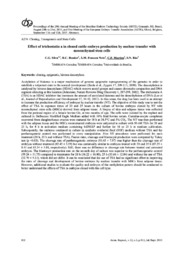Effect of trichostatin a in cloned cattle embryo production by nuclear transfer with mesenchymal stem cells.
Effect of trichostatin a in cloned cattle embryo production by nuclear transfer with mesenchymal stem cells.
Autoria: SILVA, C. G.; CUMPA, H. C. B.; FONSECA NETO, A. M. da; MARTINS, C. F.; BÁO, S. N.
Resumo: Acetylation of histones is a major mechanism of genome epigenetic reprogramming of the gametes in order to establish a totipotent state to the normal development (Ikeda et al., Zygote 17, 209-215, 2009). The deacetylation is catalysed by histone deacetylases (HDAC) which remove acetyl groups and causes chromatin compaction and DNA segment silencing at this location (Johnstone, Nature Reviews Drug Discovery 1, 287-299, 2002). The trichostatin A (TSA) is an HDAC inhibitor that increases the amount of acetylated histones and the demethylation of DNA (Lee et al., Journal of Reproduction and Development 57, 34-42, 2011). In this sense, the drug has been used in an attempt to increase the production efficiency of embryos by nuclear transfer (NT). The objective of this study was to test the effect of TSA in exposure times of 20 and 25 hours in the culture of bovine embryos cloned by NT with mesenchymal stem cells (MSCs) derived from adipose tissue. A biopsy of skin and adipose tissue was collected from the perineal region of a female bovine Gir, at two months of age. The cells were isolated by the explant and cultured in Dulbeccos Modified Eagle Medium added with 10% fetal bovine serum. Cumulus-oocyte complexes recovered from slaughterhouse ovaries were matured for 18 h at 38.5°C and 5% CO2. The NT was then performed with the adipose tissue and the MSCs reconstructed embryos were subjected to culture with 50 nM TSA for 20 and 25 h, for 4 h in activation medium containing 6-DMAP and further for 16 or 21 h in medium cultivation. Subsequently, the embryos continued in culture in synthetic oviductal fluid (SOF) medium without TSA and the parthenogenetic control was performed in every manipulation. Five NT procedures were performed for each treatment (20 h, 25 h and without TSA). Fusion rates, cleavage and blastocyst production were compared by Tukey test (p <0.05). The cleavage rate of parthenogenetic embryos (93.45 ± 7.97) was higher than the cleavage rate of embryos without treatment (82.45 ± 5.59) but was statistically similar to embryos treated with 20 and 25 h (87.25 ± 8.41 and 85.54 ± 3.88, respectively). Still, there was no difference in cleavage rate between treated and untreated embryos. The blastocyst production rate on the seventh day of culture was superior to the parthenogenetic control (59.24 ± 11.75) compared to treatments for 20 h (36.22 ± 16.80), 25 h (33.66 ± 12.84) and without the use of TSA (32.70 ± 9.11), which did not differ. It can be concluded that the use of TSA had no significant effect in improving the rates of cleavage and development of bovine embryos by nuclear transfer with MSCs from adipose tissue. However, additional studies to evaluate the quality and embryos of the methylation pattern should be conducted to better understand the effects of TSA in embryos cloned with this cell type.
Ano de publicação: 2015
Tipo de publicação: Resumo em anais e proceedings
Unidade: Embrapa Cerrados
Palavras-chave: Clonagem, Cloning, Epigenetic, histone deacetylase
Observações
1 - Por padrão são exibidas publicações dos últimos 20 anos. Para encontrar publicações mais antigas, configure o filtro ano de publicação, colocando o ano a partir do qual você deseja encontrar publicações. O filtro está na coluna da esquerda na busca acima.
2 - Para ler algumas publicações da Embrapa (apenas as que estão em formato ePub), é necessário ter, no celular ou computador, um desses softwares gratuitos. Sistemas Android: Google Play Livros; IOS: iBooks; Windows e Linux: software Calibre.
Acesse outras publicações
Acesse a Base de Dados da Pesquisa Agropecuária (BDPA) para consultar o acervo completo das bibliotecas da Embrapa.

